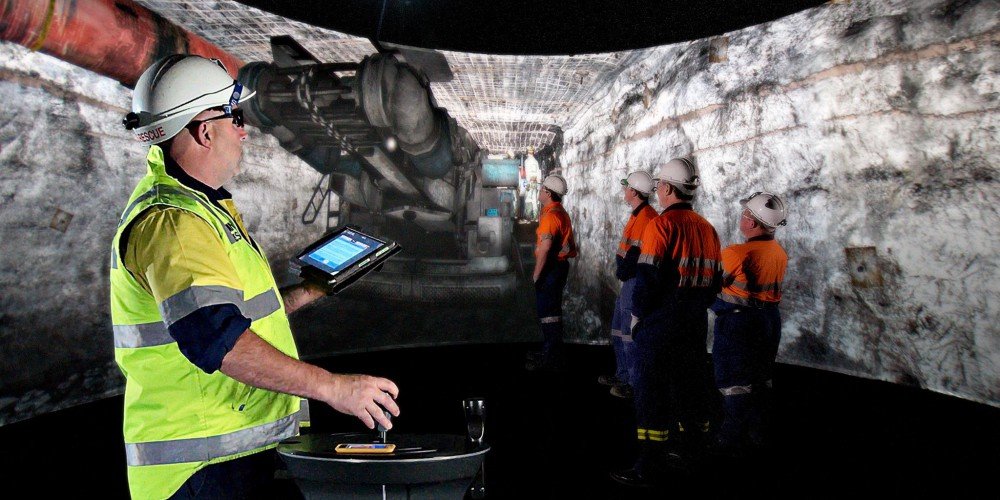TECHNOLOGY
How Virtual & Augmented Reality are Revolutionizing the Mining Industry

Virtual reality (VR) and augmented reality (AR) are technologies that are quickly becoming great tools for many types of industries.
From tourism to manufacturing and everything in between, both Augmented and Virtual reality are truly changing the way that things work. One industry where VR and AR is relevant and is offering a significant change to the way things are done is the mining industry. More and more mining companies are turning to these technologies as a way to improve safety, efficiency, and to drive innovation.
Over the past several years the mining industry has invested about 0.5 percent of their revenues into R&D. The investment into new innovations such as augmented reality and virtual reality technologies will help to insulate the mining industry from volatility and will also help to ensure future profitability.
There are several ways that both virtual and augmented reality can be useful in the mining industry. Some of the ways that VR and AR can be utilized include for equipment training, safety training, field solutions, and to provide site tours of the mines.
Let’s take a closer look at what VR and AR are as well as the different ways that both of these types of technologies are already being used and may be used in the future for the mining industry.
What is the Difference Between Virtual and Augmented Reality?

When it comes to understanding how virtual reality and augmented reality can help revolutionize the mining industry, the first step is to understand exactly how each of these technologies work. Many people do not understand the difference between these two technologies.
Virtual Reality
Virtual reality is a computer generated stimulation. It is artificial and recreates a real life situation or environment. Users are immersed in the virtual world. They feel like they are enveloped in reality firsthand. This is primarily through hearing and vision.
Typically, virtual reality will be delivered through a headset that is equipped with the technology. Most often, virtual reality is used to enhance reality for entertainment or gaming. It is also used to enhance training in a real life environment by simulating a reality for people to practice beforehand. One prime example of this is a flight simulator used by pilots. In the mining industry it can be used to create practice scenarios of where dynamite can be placed in order to create the appropriate cracks and to avoid avalanches and other dangerous situations.
Augmented Reality
Augmented reality uses layers of computer generated enhancements on top of existing reality. This makes it more meaningful when interacting with it. Augmented reality is developed as apps and then used on a mobile device to blend a digital component with the real world. This is completed in a way that enhances both realities, but it can also be easily told apart.
AR is becoming more and more mainstream as it is used in 3D photos, emails, and texts for mobile devices, and for overlays for televised sports. The tech industry uses motion activated commands and holograms as well as other revolutionary things.
Differences between AR and VR
The main difference between AR and VR is that VR recreates a real life setting digitally, while AR uses virtual elements as overlays for the real world.
Why Use Virtual Reality in Mines?

Virtual reality and augmented reality can greatly change the landscape of how training is conducted, especially in jobs that are dangerous, such as mining. Using controlled explosives in mines is extremely important. However, this can be quite dangerous and even deadly if they are not handled correctly.
If the explosives are not placed in the correct locations and accurate measurements are not made, the rocks may fracture in ways that are not expected. This can create a hazardous situation, not only underground, but above the surface as well.
Virtual reality provides a way to practice the art of placing explosives without any of the danger by using a simulated VR mine.
How is Virtual Reality Being Used in the Mining Industry So Far?
Simulated Training Solutions, which is a South African company, created the first VR blast wall in 2016. This VR blast wall was installed in Zambia at the Mopani Copper Mines. Since this first wall was installed, there have been two others that have been installed in locations in South Africa and there is a third that is being created.

This training device allows trainees to practice their skills. While sitting in a dark training room, users will see a rock projected onto a large interactive canvas. An electronic spray can will be used to mark the measured blast holes. Once the blast holes have been marked, the trainee will then be able to practice detonating the explosives in the correct sequence. As they are doing this they can watch to see how the rocks react and fracture. Any mistakes that are made are highlighted through the markings.
These virtual walls are a very close representation of what miners will be dealing with when working in the real world. This means that the virtual technology is providing extremely effective job training for miners. In the past blackboard exercises and videos were relied on for training and these methods are simply not as effective as the virtual wall.
When the virtual technology is used to train blasters, they come out of the training more prepared. When the blasters are well-trained, it translates into savings for mine operators as any blast that goes wrong can result in labour costs, clean up costs, and delayed production.
Technology and Mine Operation
Virtual and augmented reality are not the only new technologies that are being used throughout the mining industry. There are many other technologies that are helping to create a safer work environment for miners.
Some innovations that have been implemented throughout the mining industry include the use of autonomous trucks and drills as well as the use of drones. Drones can be used for a number of applications including equipment inspection, evaluating terrain, and filming blasts. Typically, a drone will provide safe and quick access to different aspects of the mining operation that are in places that are high up or otherwise difficult to reach.

Autonomous trucks and drills have greatly improved productivity as well as on site safety. This type of equipment allows a single operator to be in charge of several drills at once. An autonomous system will also create drilling data that can be used for achieving a better blast and to estimate the ore seam size. The data that is gathered can improve decision making in real time, which is a big benefit of this technology.
Perhaps the most important thing that these types of autonomous drills can do is to remove people from the line of fire. This reduces a person’s exposure to risks and hazards that are associated with operating this type of large equipment. It also reduced injuries related to fatigue.
Addressing Environmental and Social Issues of Mining
In addition to addressing the safety and productivity in the mining industry, new technology is also offering a way to address some of the environmental and social issues that the mining industry faces.
Cobalt is a metal that is mined and used for the batteries found in some cars and in most smartphones. More than half of the cobalt in the world comes from the Dominican Republic and many of the people who work in these cobalt mines are children. In fact, it is estimated that there are over 40,000 children working in the mining industry.
With these new technologies that are coming into place, the hope is that using virtual reality for training as well as autonomous trucks and drills, can help to get some of these children out of the mines.
Creating an Intelligent Mine: Mine Design & Planning
The goal of some companies is to create what is being referred to as an intelligent mine in the near future. There are several solutions currently available that can make this goal a reality in a short amount of time simply by implementing just a few small changes.
Mine Life VR is a product created by LlamaZoo that provides a full spectrum of data sets and design iterations for mine planning. It allows resource management and allocation of resources so mining companies can optimize their offerings. It also allows investors and community relations by giving users a chance to view a virtual tour of the mine site in real time 3D which before has never been provided.
Working in the mining industry has always been quite a dangerous job. Going down into the mines with the risk of cave-ins and other issues combined with the use of explosives on site, have made this job one that is extremely risky. In addition, children being used to do these types of jobs is deemed unethical by many.
For this reason, knowing that there is emerging technology that can help create a safer environment for the people who work in the mining industry is a good thing. Through the use of virtual and augmented reality, a safer work environment can be created by training miners thoroughly and providing an environment that is not only safer to work in, but also more productive.
Source link
TECHNOLOGY
Next-gen chips, Amazon Q, and speedy S3

AWS re:Invent, which has been taking place from November 27 and runs to December 1, has had its usual plethora of announcements: a total of 21 at time of print.
Perhaps not surprisingly, given the huge potential impact of generative AI – ChatGPT officially turns one year old today – a lot of focus has been on the AI side for AWS’ announcements, including a major partnership inked with NVIDIA across infrastructure, software, and services.
Yet there has been plenty more announced at the Las Vegas jamboree besides. Here, CloudTech rounds up the best of the rest:
Next-generation chips
This was the other major AI-focused announcement at re:Invent: the launch of two new chips, AWS Graviton4 and AWS Trainium2, for training and running AI and machine learning (ML) models, among other customer workloads. Graviton4 shapes up against its predecessor with 30% better compute performance, 50% more cores and 75% more memory bandwidth, while Trainium2 delivers up to four times faster training than before and will be able to be deployed in EC2 UltraClusters of up to 100,000 chips.
The EC2 UltraClusters are designed to ‘deliver the highest performance, most energy efficient AI model training infrastructure in the cloud’, as AWS puts it. With it, customers will be able to train large language models in ‘a fraction of the time’, as well as double energy efficiency.
As ever, AWS offers customers who are already utilising these tools. Databricks, Epic and SAP are among the companies cited as using the new AWS-designed chips.
Zero-ETL integrations
AWS announced new Amazon Aurora PostgreSQL, Amazon DynamoDB, and Amazon Relational Database Services (Amazon RDS) for MySQL integrations with Amazon Redshift, AWS’ cloud data warehouse. The zero-ETL integrations – eliminating the need to build ETL (extract, transform, load) data pipelines – make it easier to connect and analyse transactional data across various relational and non-relational databases in Amazon Redshift.
A simple example of how zero-ETL functions can be seen is in a hypothetical company which stores transactional data – time of transaction, items bought, where the transaction occurred – in a relational database, but use another analytics tool to analyse data in a non-relational database. To connect it all up, companies would previously have to construct ETL data pipelines which are a time and money sink.
The latest integrations “build on AWS’s zero-ETL foundation… so customers can quickly and easily connect all of their data, no matter where it lives,” the company said.
Amazon S3 Express One Zone
AWS announced the general availability of Amazon S3 Express One Zone, a new storage class purpose-built for customers’ most frequently-accessed data. Data access speed is up to 10 times faster and request costs up to 50% lower than standard S3. Companies can also opt to collocate their Amazon S3 Express One Zone data in the same availability zone as their compute resources.
Companies and partners who are using Amazon S3 Express One Zone include ChaosSearch, Cloudera, and Pinterest.
Amazon Q
A new product, and an interesting pivot, again with generative AI at its core. Amazon Q was announced as a ‘new type of generative AI-powered assistant’ which can be tailored to a customer’s business. “Customers can get fast, relevant answers to pressing questions, generate content, and take actions – all informed by a customer’s information repositories, code, and enterprise systems,” AWS added. The service also can assist companies building on AWS, as well as companies using AWS applications for business intelligence, contact centres, and supply chain management.
Customers cited as early adopters include Accenture, BMW and Wunderkind.
Want to learn more about cybersecurity and the cloud from industry leaders? Check out Cyber Security & Cloud Expo taking place in Amsterdam, California, and London. Explore other upcoming enterprise technology events and webinars powered by TechForge here.
TECHNOLOGY
HCLTech and Cisco create collaborative hybrid workplaces

Digital comms specialist Cisco and global tech firm HCLTech have teamed up to launch Meeting-Rooms-as-a-Service (MRaaS).
Available on a subscription model, this solution modernises legacy meeting rooms and enables users to join meetings from any meeting solution provider using Webex devices.
The MRaaS solution helps enterprises simplify the design, implementation and maintenance of integrated meeting rooms, enabling seamless collaboration for their globally distributed hybrid workforces.
Rakshit Ghura, senior VP and Global head of digital workplace services, HCLTech, said: “MRaaS combines our consulting and managed services expertise with Cisco’s proficiency in Webex devices to change the way employees conceptualise, organise and interact in a collaborative environment for a modern hybrid work model.
“The common vision of our partnership is to elevate the collaboration experience at work and drive productivity through modern meeting rooms.”
Alexandra Zagury, VP of partner managed and as-a-Service Sales at Cisco, said: “Our partnership with HCLTech helps our clients transform their offices through cost-effective managed services that support the ongoing evolution of workspaces.
“As we reimagine the modern office, we are making it easier to support collaboration and productivity among workers, whether they are in the office or elsewhere.”
Cisco’s Webex collaboration devices harness the power of artificial intelligence to offer intuitive, seamless collaboration experiences, enabling meeting rooms with smart features such as meeting zones, intelligent people framing, optimised attendee audio and background noise removal, among others.
Want to learn more about cybersecurity and the cloud from industry leaders? Check out Cyber Security & Cloud Expo taking place in Amsterdam, California, and London. Explore other upcoming enterprise technology events and webinars powered by TechForge here.
TECHNOLOGY
Canonical releases low-touch private cloud MicroCloud

Canonical has announced the general availability of MicroCloud, a low-touch, open source cloud solution. MicroCloud is part of Canonical’s growing cloud infrastructure portfolio.
It is purpose-built for scalable clusters and edge deployments for all types of enterprises. It is designed with simplicity, security and automation in mind, minimising the time and effort to both deploy and maintain it. Conveniently, enterprise support for MicroCloud is offered as part of Canonical’s Ubuntu Pro subscription, with several support tiers available, and priced per node.
MicroClouds are optimised for repeatable and reliable remote deployments. A single command initiates the orchestration and clustering of various components with minimal involvement by the user, resulting in a fully functional cloud within minutes. This simplified deployment process significantly reduces the barrier to entry, putting a production-grade cloud at everyone’s fingertips.
Juan Manuel Ventura, head of architectures & technologies at Spindox, said: “Cloud computing is not only about technology, it’s the beating heart of any modern industrial transformation, driving agility and innovation. Our mission is to provide our customers with the most effective ways to innovate and bring value; having a complexity-free cloud infrastructure is one important piece of that puzzle. With MicroCloud, the focus shifts away from struggling with cloud operations to solving real business challenges” says
In addition to seamless deployment, MicroCloud prioritises security and ease of maintenance. All MicroCloud components are built with strict confinement for increased security, with over-the-air transactional updates that preserve data and roll back on errors automatically. Upgrades to newer versions are handled automatically and without downtime, with the mechanisms to hold or schedule them as needed.
With this approach, MicroCloud caters to both on-premise clouds but also edge deployments at remote locations, allowing organisations to use the same infrastructure primitives and services wherever they are needed. It is suitable for business-in-branch office locations or industrial use inside a factory, as well as distributed locations where the focus is on replicability and unattended operations.
Cedric Gegout, VP of product at Canonical, said: “As data becomes more distributed, the infrastructure has to follow. Cloud computing is now distributed, spanning across data centres, far and near edge computing appliances. MicroCloud is our answer to that.
“By packaging known infrastructure primitives in a portable and unattended way, we are delivering a simpler, more prescriptive cloud experience that makes zero-ops a reality for many Industries.“
MicroCloud’s lightweight architecture makes it usable on both commodity and high-end hardware, with several ways to further reduce its footprint depending on your workload needs. In addition to the standard Ubuntu Server or Desktop, MicroClouds can be run on Ubuntu Core – a lightweight OS optimised for the edge. With Ubuntu Core, MicroClouds are a perfect solution for far-edge locations with limited computing capabilities. Users can choose to run their workloads using Kubernetes or via system containers. System containers based on LXD behave similarly to traditional VMs but consume fewer resources while providing bare-metal performance.
Coupled with Canonical’s Ubuntu Pro + Support subscription, MicroCloud users can benefit from an enterprise-grade open source cloud solution that is fully supported and with better economics. An Ubuntu Pro subscription offers security maintenance for the broadest collection of open-source software available from a single vendor today. It covers over 30k packages with a consistent security maintenance commitment, and additional features such as kernel livepatch, systems management at scale, certified compliance and hardening profiles enabling easy adoption for enterprises. With per-node pricing and no hidden fees, customers can rest assured that their environment is secure and supported without the expensive price tag typically associated with cloud solutions.
Want to learn more about cybersecurity and the cloud from industry leaders? Check out Cyber Security & Cloud Expo taking place in Amsterdam, California, and London. Explore other upcoming enterprise technology events and webinars powered by TechForge here.
-

 WORDPRESS7 days ago
WORDPRESS7 days agoTurkish startup ikas attracts $20M for its e-commerce platform designed for small businesses
-

 MARKETING6 days ago
MARKETING6 days agoRoundel Media Studio: What to Expect From Target’s New Self-Service Platform
-

 SEO6 days ago
SEO6 days agoGoogle Limits News Links In California Over Proposed ‘Link Tax’ Law
-
SEARCHENGINES6 days ago
Daily Search Forum Recap: April 12, 2024
-

 SEO5 days ago
SEO5 days ago10 Paid Search & PPC Planning Best Practices
-

 SEARCHENGINES5 days ago
SEARCHENGINES5 days agoGoogle Core Update Volatility, Helpful Content Update Gone, Dangerous Google Search Results & Google Ads Confusion
-

 SEO7 days ago
SEO7 days agoGoogle Unplugs “Notes on Search” Experiment
-

 MARKETING5 days ago
MARKETING5 days ago2 Ways to Take Back the Power in Your Business: Part 2















You must be logged in to post a comment Login